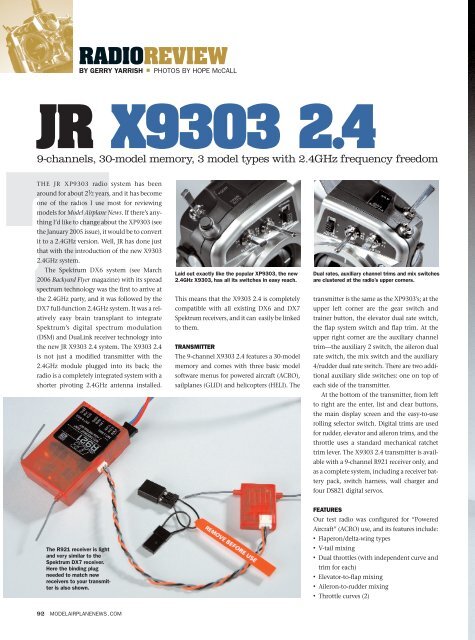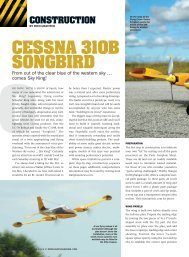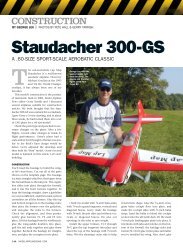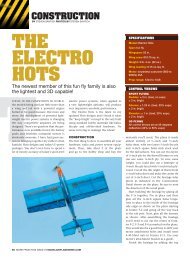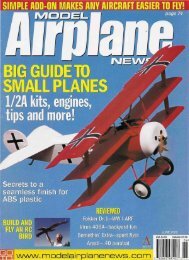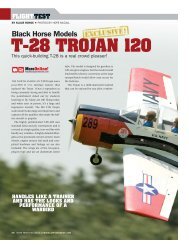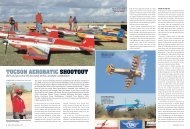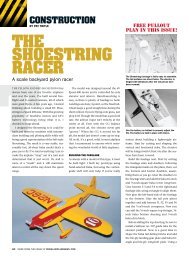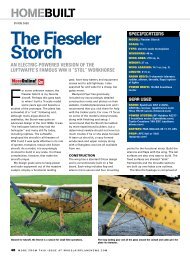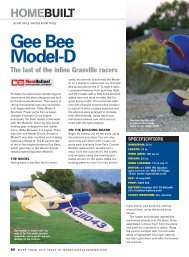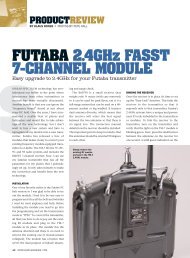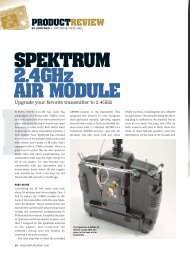JR X9303 2.4
JR X9303 2.4
JR X9303 2.4
Create successful ePaper yourself
Turn your PDF publications into a flip-book with our unique Google optimized e-Paper software.
RADIOREVIEW<br />
BY GERRY YARRISH PHOTOS BY HOPE McCALL<br />
<strong>JR</strong> <strong>X9303</strong> <strong>2.4</strong><br />
9-channels, 30-model memory, 3 model types with <strong>2.4</strong>GHz frequency freedom<br />
TTHE <strong>JR</strong> XP9303 radio system has been<br />
around for about 21 ⁄2 years, and it has become<br />
one of the radios I use most for reviewing<br />
models for Model Airplane News. If there’s anything<br />
I’d like to change about the XP9303 (see<br />
the January 2005 issue), it would be to convert<br />
it to a <strong>2.4</strong>GHz version. Well, <strong>JR</strong> has done just<br />
that with the introduction of the new <strong>X9303</strong><br />
<strong>2.4</strong>GHz system.<br />
The Spektrum DX6 system (see March<br />
2006 Backyard Flyer magazine) with its spread<br />
spectrum technology was the first to arrive at<br />
the <strong>2.4</strong>GHz party, and it was followed by the<br />
DX7 full-function <strong>2.4</strong>GHz system. It was a relatively<br />
easy brain transplant to integrate<br />
Spektrum’s digital spectrum modulation<br />
(DSM) and DuaLink receiver technology into<br />
the new <strong>JR</strong> <strong>X9303</strong> <strong>2.4</strong> system. The <strong>X9303</strong> <strong>2.4</strong><br />
is not just a modified transmitter with the<br />
<strong>2.4</strong>GHz module plugged into its back; the<br />
radio is a completely integrated system with a<br />
shorter pivoting <strong>2.4</strong>GHz antenna installed.<br />
The R921 receiver is light<br />
and very similar to the<br />
Spektrum DX7 receiver.<br />
Here the binding plug<br />
needed to match new<br />
receivers to your transmitter<br />
is also shown.<br />
92 MODELAIRPLANENEWS.COM<br />
Laid out exactly like the popular XP9303, the new<br />
<strong>2.4</strong>GHz <strong>X9303</strong>, has all its switches in easy reach.<br />
This means that the <strong>X9303</strong> <strong>2.4</strong> is completely<br />
compatible with all existing DX6 and DX7<br />
Spektrum receivers, and it can easily be linked<br />
to them.<br />
TRANSMITTER<br />
The 9-channel <strong>X9303</strong> <strong>2.4</strong> features a 30-model<br />
memory and comes with three basic model<br />
software menus for powered aircraft (ACRO),<br />
sailplanes (GLID) and helicopters (HELI). The<br />
Dual rates, auxiliary channel trims and mix switches<br />
are clustered at the radio’s upper corners.<br />
transmitter is the same as the XP9303’s; at the<br />
upper left corner are the gear switch and<br />
trainer button, the elevator dual rate switch,<br />
the flap system switch and flap trim. At the<br />
upper right corner are the auxiliary channel<br />
trim—the auxiliary 2 switch, the aileron dual<br />
rate switch, the mix switch and the auxiliary<br />
4/rudder dual rate switch. There are two additional<br />
auxiliary slide switches: one on top of<br />
each side of the transmitter.<br />
At the bottom of the transmitter, from left<br />
to right are the enter, list and clear buttons,<br />
the main display screen and the easy-to-use<br />
rolling selector switch. Digital trims are used<br />
for rudder, elevator and aileron trims, and the<br />
throttle uses a standard mechanical ratchet<br />
trim lever. The <strong>X9303</strong> <strong>2.4</strong> transmitter is available<br />
with a 9-channel R921 receiver only, and<br />
as a complete system, including a receiver battery<br />
pack, switch harness, wall charger and<br />
four DS821 digital servos.<br />
FEATURES<br />
Our test radio was configured for “Powered<br />
Aircraft” (ACRO) use, and its features include:<br />
• Flaperon/delta-wing types<br />
• V-tail mixing<br />
• Dual throttles (with independent curve and<br />
trim for each)<br />
• Elevator-to-flap mixing<br />
• Aileron-to-rudder mixing<br />
• Throttle curves (2)
TRANSMITTER<br />
MANUFACTURER <strong>JR</strong><br />
DISTRIBUTOR Horizon Hobby Distributors<br />
MODEL <strong>X9303</strong> <strong>2.4</strong><br />
TYPE Aircraft<br />
ENCODER 9-channel computer system<br />
RF MODULE Fully integrated <strong>2.4</strong>GHz<br />
FREQUENCY BAND <strong>2.4</strong>00 to <strong>2.4</strong>83GHz<br />
MODULATION Digital Spectrum Modulation<br />
(DSM) with Direct Sequence Spread<br />
Spectrum<br />
SERVO-CHANNEL RESOLUTION 1024 w/4X<br />
over-sampling<br />
SPECTRAL CAPACITY 40 systems<br />
POWER SOURCE 1500mAh 9.6V NiMH<br />
RECEIVER<br />
MODEL <strong>JR</strong>921 <strong>2.4</strong><br />
TYPE DSM2 DuaLink<br />
NO. OF CHANNELS 9<br />
FREQUENCY <strong>2.4</strong>GHz<br />
RECEIVER VOLTAGE RANGE<br />
3.5 to 9V DC<br />
WEIGHT 0.53 oz. (15g)<br />
SYSTEM PRICE $730<br />
(w/4 high-torque digital<br />
821 servos)<br />
<strong>JR</strong> <strong>X9303</strong> <strong>2.4</strong><br />
THE <strong>X9303</strong> <strong>2.4</strong><br />
HAS THE SAME<br />
GREAT FEATURES<br />
AS THE 9-CHANNEL,<br />
30-MODEL MEMORY,<br />
3-MODEL XP3903<br />
RADIO SYSTEM<br />
AUGUST 2007 93
RADIOREVIEW <strong>JR</strong> <strong>X9303</strong> <strong>2.4</strong><br />
The main screen on the <strong>X9303</strong> <strong>2.4</strong> is very easy to read. Navigation and adjustment of the radio’s various<br />
menus is made easy with the unique roller selector switch to the right of the screen.<br />
• Flap system (3-position with elevator compensation<br />
and delay)<br />
• Snap-roll system (with 4 directions<br />
and rates)<br />
• Gyro system (3 gains for up to 2 gyros)<br />
• Servo-speed adjustment (in both directions)<br />
• Programmable mixers (6 total; 2 with<br />
multipoint adjustment)<br />
• Direct servo control (DSC)<br />
MAIN DISPLAY<br />
There’s very little confusion while navigating<br />
the transmitter’s many program menus. The<br />
main display shows the current model type<br />
(with a graphic symbol) the trim positions,<br />
the battery voltage, the model number and<br />
the model’s name if you input that information.<br />
The function screen is where you find<br />
menus for dual rates/expo, servo-reversing,<br />
subtrim, servo-travel adjustment, elevator-toflap<br />
and aileron-to-rudder mixing, throttle<br />
curves, flap system, servo speed, snap roll,<br />
servo-speed adjustment and programmable<br />
mixers 1 through 6. You also find the trainer,<br />
timer and servo monitor menus.<br />
In the system menus (press the enter button<br />
and turn on the radio), you find the model<br />
select, model name, type select, model memory<br />
reset, data transfer, trim step function, device<br />
(switch) selection and wing-type menus.<br />
The navigation and adjustment of these program<br />
functions is well detailed in my XP9303<br />
review, and the process is easy and intuitive.<br />
MODELMATCH<br />
This feature puts an end to the “wrong model<br />
94 MODELAIRPLANENEWS.COM<br />
syndrome” if you neglect to double-check that<br />
you have the correct model name on the transmitter<br />
display before you fly your model. A<br />
unique code embedded in the signal, will prevent<br />
the receiver from responding if the wrong<br />
model’s name is on the transmitter’s screen.<br />
SERVOSYNC<br />
This new feature actually re-sequences data<br />
the transmitter transmits based on the type of<br />
mixing you select. So, if you use dual elevators<br />
on a giant model or a 3-servo CCPM setup for<br />
<strong>X9303</strong> <strong>2.4</strong> FEATURES<br />
The <strong>X9303</strong> <strong>2.4</strong> has aircraft, sailplane<br />
and helicopter software menus.<br />
Here are the basic aircraft program<br />
features:<br />
■ Switch assignment<br />
■ Flight modes (3 aircraft, 5 sailplane, 6<br />
helicopter)<br />
■ Dual rates for aileron, rudder and<br />
elevator (3 with flight modes)<br />
■ Adjustable flight trims<br />
■ Fail-safe (with hold and predetermined<br />
servo positioning)<br />
■ Trainer system (selectable channels)<br />
■ Timers (stopwatch, countdown and<br />
integrated)<br />
■ Servo monitor<br />
■ ModelMatch<br />
■ ServoSync<br />
■ Model memory transfer system<br />
■ Model copy system<br />
your helicopter, ServoSync ensures that the<br />
servos that work together will receive their<br />
impulses together. This allows the servo<br />
movements to be more synchronized for<br />
improved response.<br />
RECEIVER<br />
The <strong>JR</strong> R921 <strong>2.4</strong> is a full-range receiver featuring<br />
DuaLink technology and is actually two<br />
receivers that each has its own set of antennas.<br />
When powered up, the receiver scans the<br />
<strong>2.4</strong>GHz band to find the transmitter it has been<br />
programmed to recognize, and it locks on to its<br />
signal. The second receiver circuit then repeats<br />
the process and locks on to a second signal to<br />
establish a dual-signal link to the transmitter.<br />
The two antennas virtually eliminate<br />
blocked-signal interference from nearby metal<br />
objects such as big glow- and gas-powered<br />
models and large battery packs. As with all<br />
<strong>2.4</strong>GHz radio systems, the transmitter signal<br />
beam is line-of-sight, so always avoid flying<br />
behind large buildings or objects that could<br />
block the signal.<br />
Binding. Binding programs the receiver to recognize<br />
your transmitter, and it’s done at the<br />
factory. Binding or rebinding is necessary if<br />
you purchase another receiver to use with<br />
your transmitter and if you want to change<br />
the built-in throttle-smart fail-safe settings.<br />
Smart fail-safe. This built-in feature is set so that<br />
if there is a signal loss, the throttle will go to a<br />
low setting, and the other control channels will<br />
remain in their last positions. If you turn on the<br />
receiver before the transmitter, all the channels<br />
go to their fail-safe positions (set during the<br />
binding process), but as a safety feature, the<br />
throttle channel does not produce a signal<br />
pulse, so it can’t activate an electric model’s<br />
ESC. The instruction manual explains the<br />
binding and fail-safe setting processes in detail.<br />
BOTTOM LINE<br />
The <strong>JR</strong> <strong>X9303</strong> <strong>2.4</strong> is a user-friendly radio system<br />
that’s ideally suited to intermediate to<br />
expert fliers. I especially like the fact that with<br />
its transfer system, you can easily bring all<br />
your XP9303 model memories into the <strong>X9303</strong><br />
<strong>2.4</strong>. This is a real time saver. Add the<br />
frequency freedom of DSM <strong>2.4</strong>GHz frequency<br />
modulation and the ability to link to all older<br />
Spektrum receivers, and you have a radio<br />
system that’s ideal types of RC flying.<br />
See the Source Guide for manufacturers’ contact information.


